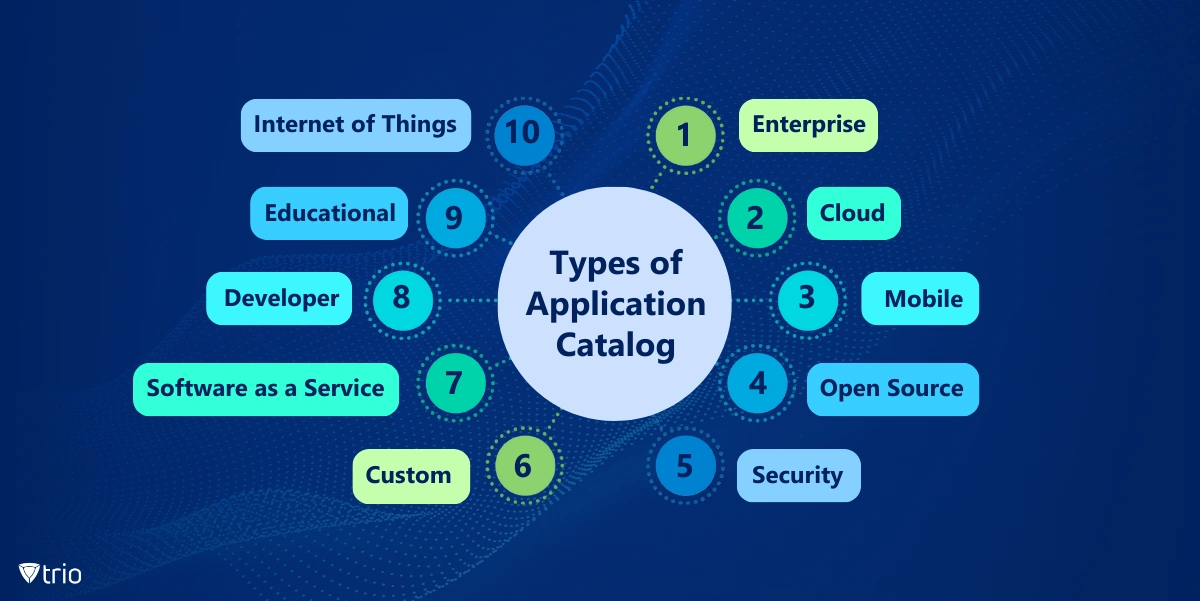What Is an Application Catalog?
An application catalog, also known as an app catalog, is a centralized repository or database that contains a list of software applications or services available for use within a particular environment or organization. This catalog provides users with a convenient way to discover, request, and access various applications that have been approved or sanctioned for use. Mobile Device Management (MDM) solutions such as Trio are software that have application catalogs. Key features of an application catalog include:
- Centralized Repository: The catalog serves as a centralized location where information about available applications is stored. This can include details such as application descriptions, version numbers, compatibility information, and user ratings.
- Curation and Approval: Before an application is included in the catalog, it often goes through a vetting process to ensure it meets certain criteria, such as security standards, compliance requirements, and organizational policies. This helps in maintaining a level of quality and security for the applications listed.
- User-Friendly Interface: The catalog typically provides a user-friendly interface that allows individuals to browse through the available applications, search for specific ones, and view relevant information about each application.
- Updates and Maintenance: The catalog can be used to manage updates and maintenance of applications. Users can be notified of new versions, patches, or updates available for the applications they use.
- Visibility and Compliance: The catalog provides visibility into the software landscape within an organization, helping administrators and IT teams ensure that the software in use complies with licensing agreements, security standards, and other regulatory requirements.
- Self-Service Capabilities: Some application catalogs offer self-service capabilities, allowing users to independently install or update applications without requiring direct IT intervention. This can improve efficiency and user satisfaction.

Types of Application Catalog
Application catalogs are commonly used in enterprise environments, educational institutions, and other organizations where there is a need to manage, control, and remotely control the deployment of software applications across a network. They contribute to better organization, security, and governance of the software ecosystem within an entity. There are various types of application catalogs, each serving specific purposes based on organizational needs and contexts. Here are some common types you can use as application catalog templates:
-
Enterprise Application Catalog:
- Purpose: Manages and distributes applications within an enterprise environment.
- Scope: Typically used in large organizations to control and distribute software to employees.
-
Cloud Application Catalog:
- Purpose: Manages cloud-based applications and services.
- Scope: Relevant for organizations using cloud platforms, enabling users to discover and use cloud-based applications.
-
Mobile Application Catalog:
- Purpose: Manages mobile applications for smartphones and tablets.
- Scope: Used in organizations where employees use mobile devices for work, ensuring secure and controlled access to mobile apps.
-
Open Source Application Catalog:
- Purpose: Catalog of open-source software applications.
- Scope: Useful for organizations that rely heavily on open-source solutions, facilitating discovery and deployment.
-
Security Application Catalog:
- Purpose: Focuses on security-related applications and tools.
- Scope: Helps manage and distribute security software to protect the organization’s IT infrastructure.
-
Custom Application Catalog:
- Purpose: Tailored to specific organizational needs.
- Scope: Organizations may create custom catalogs to manage applications unique to their industry or workflow.
-
Software as a Service (SaaS) Application Catalog:
- Purpose: Manages and distributes SaaS applications.
- Scope: Useful for organizations using a variety of cloud-based software services.
-
Developer Application Catalog:
- Purpose: Manages applications and tools for software developers.
- Scope: Helps developers discover, request, and use development tools and libraries.
-
Educational Application Catalog:
- Purpose: Manages educational software used in academic institutions.
- Scope: Helps educators and students access approved educational applications.
-
IoT Application Catalog:
- Purpose: Manages applications for the Internet of Things (IoT) devices.
- Scope: Relevant in environments where IoT devices are used, providing a centralized repository for IoT applications.
The specific type of application catalog used by an organization depends on its industry, size, and the nature of its IT infrastructure. In many cases, organizations may use a combination of these catalog types to meet diverse requirements.

Tips on Building an Application Catalog for an Organization
Building an application catalog for an organization involves several steps to ensure that it meets the specific needs and requirements of the organization. Here is a general guide on how to build an application catalog:
- Define Objectives and Requirements: Understand the organization’s goals and objectives for implementing the catalog. Identify specific requirements such as security standards, compliance needs, and user access controls.
- Inventory Existing Applications: Create a comprehensive list of existing applications used within the organization. Document details for each application, including name, version, vendor, and purpose.
- Categorize Applications: Group applications into categories based on functionality, department, or usage. This categorization helps in organizing the catalog for easier navigation.
- Define Approval Processes: Establish criteria for approving new applications to be added to the catalog. Define the approval workflow, including security checks, compliance reviews, and user acceptance testing.
- Choose a Catalog Platform: Select a platform or system to host the application catalog. Options include commercial solutions, open-source tools, or custom-built systems.
- Design the Catalog Structure: Plan the layout and structure of the catalog, considering user experience and ease of navigation. Include categories, tags, and search functionalities for efficient browsing.
- Integrate with IT Infrastructure: Ensure integration with existing IT systems, such as identity management and access control systems. This integration helps in enforcing security and access policies.
- Implement User Authentication and Authorization: Implement secure authentication mechanisms to ensure that only authorized users can access and request applications. Define user roles and permissions based on organizational hierarchy and needs.
- Automate Provisioning Processes: Implement automated processes for application provisioning and de-provisioning. Integration with deployment tools can streamline the installation and updates of applications.
- Provide User Training and Support: Train users on how to use the catalog and submit application requests. Establish a support system to assist users with any issues or questions related to the catalog.
- Monitor and Update: Regularly monitor the catalog’s usage and effectiveness. Update the catalog as new applications are added, and retire outdated or unused applications.
- Promote Catalog Adoption: Communicate the benefits of the application catalog to the organization. Encourage users to use the catalog for requesting and managing applications.
- Security and Compliance: Implement security measures to protect sensitive information within the catalog. Ensure compliance with data protection regulations and organizational policies.
- Gather User Feedback: Collect feedback from users to continuously improve the catalog’s functionality and user experience.
- Documentation: Document catalog policies, procedures, and user guides for reference.
Building an application catalog is an ongoing process that requires regular updates and adjustments to meet evolving organizational needs. It’s crucial to involve key stakeholders, such as IT administrators, security teams, and end-users, throughout the development and implementation phases to ensure the catalog aligns with the organization’s goals.
Conclusion
In conclusion, an Application Catalog serves as a vital tool for organizations, providing a centralized hub for managing, distributing, and controlling software applications. The diverse types of catalogs cater to specific needs, ranging from enterprise-wide software management to educational and security-focused applications. Building a robust catalog involves strategic planning, user engagement, and adherence to security and compliance standards. By following a systematic approach, organizations can streamline application access, enhance user experience, and ensure the efficient governance of their software ecosystem. To manage this process completely, we recommend you get Trio, our excellent MDM solution. Regular monitoring, user feedback, and adaptation to evolving requirements contribute to the continued success of an application catalog, making it an indispensable asset in today’s dynamic technological landscape.







